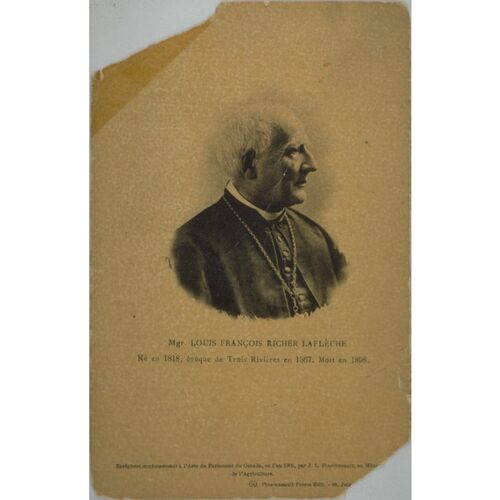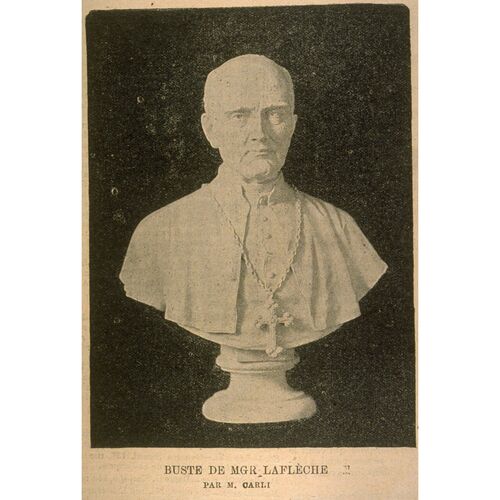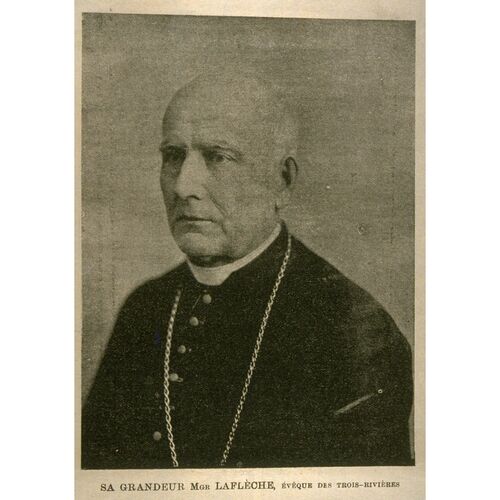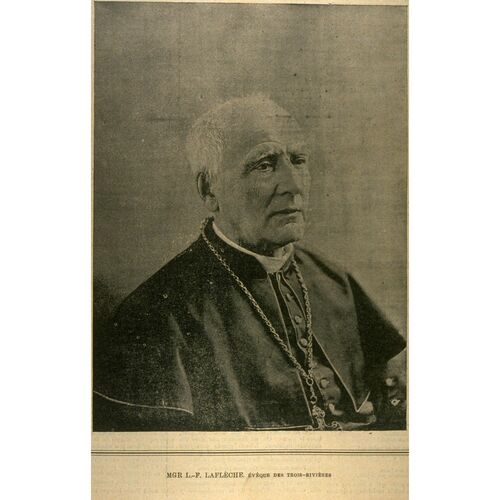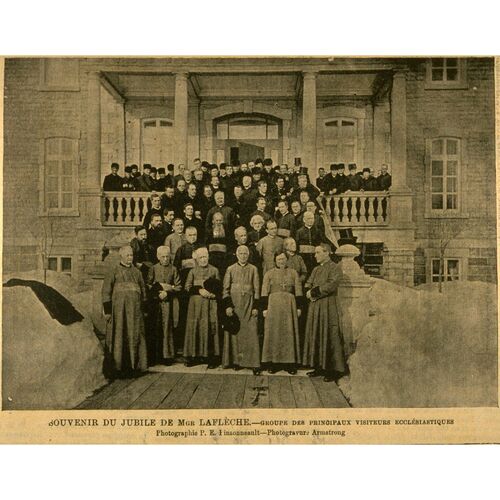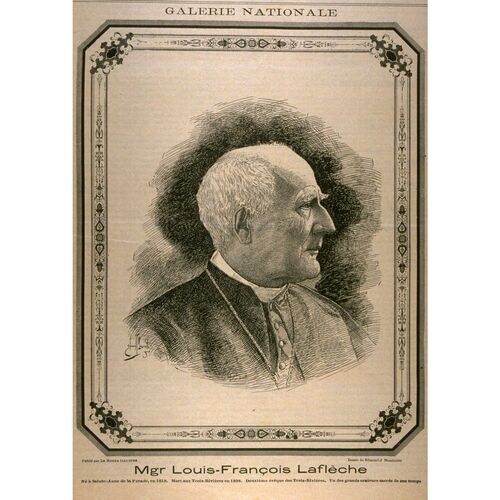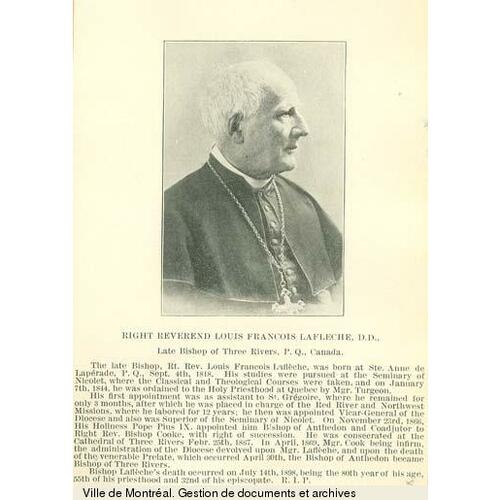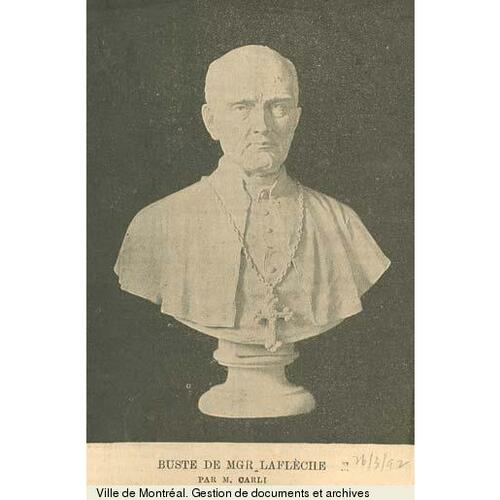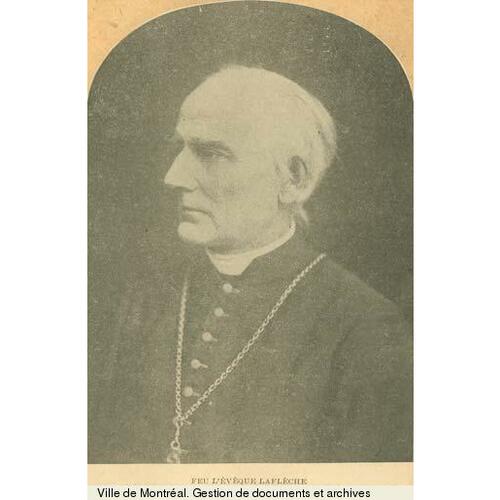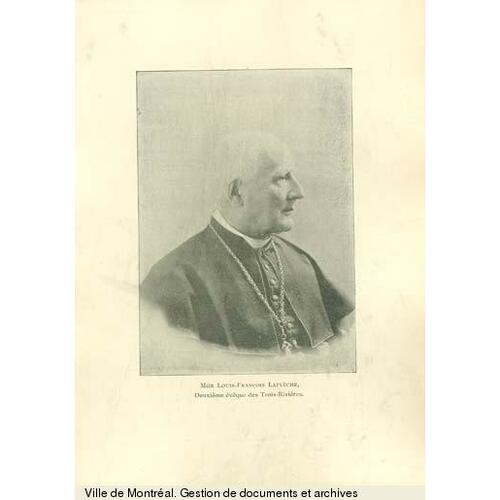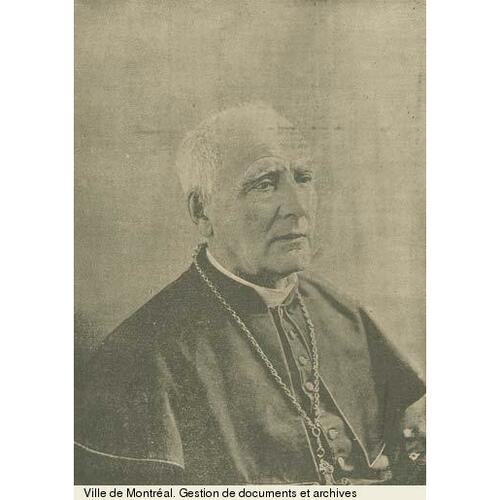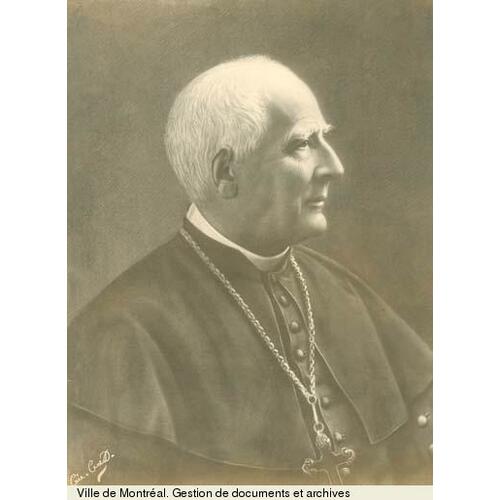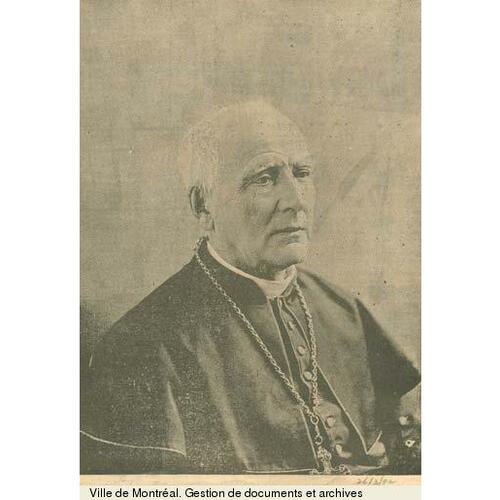As part of the funding agreement between the Dictionary of Canadian Biography and the Canadian Museum of History, we invite readers to take part in a short survey.
LAFLÈCHE, LOUIS-FRANÇOIS, Roman Catholic priest, politician, educator, author, and bishop; b. 4 Sept. 1818 in Sainte-Anne-de-la-Pérade (La Pérade), Lower Canada, son of Louis-Modeste Richer-Laflèche, a farmer, and Marie-Anne Joubin-Boisvert; d. 14 July 1898 in Trois-Rivières.
Louis-François Laflèche’s grandfather, Modeste Richer-Laflèche – “an old grumbler who is not at all easy to get along with,” according to Abbé Joseph Moll – shocked the religious authorities with his independence of mind and nationalist convictions, but was nevertheless a celebrated chief cantor in the period 1770–1834 and proved a matchless educator for the child who would become a bishop. The boy’s father, a man of a more retiring nature, ably managed a farm at Sainte-Anne-de-la-Pérade and nine other properties, as well as part of the fief of Sainte-Marie which he had received in joint ownership from his father-in-law, the seigneur Augustin Joubin-Boisvert, who was a proprietor in the North West Company. He also tried his hand at trade (buying, selling, or exchanging animals and pieces of land), made mortgage loans, and engaged for a while in the lumber industry (a sawmill on the Rivière à la Lime).
On his mother’s side Laflèche was descended from an Indian woman from the northwest. Her daughter and Laflèche’s grandmother Marie-Anne Gastineau, a Métis, had led a rather secluded life in Lower Canada devoted to prayer and reading the saints’ lives; “quiet, retiring,” she had remained homesick for the distant plains and she passed on to her grandson the touch of Indian blood that would draw sneers from some of his opponents.
The Richer-Laflèches had seven children, of whom five (two girls and three boys) reached adulthood. When the last-born child died in 1821, Louis-François became the youngest of the family. Living next door to the church and to the merchant and Liberal Pierre-Antoine Dorion* (heaven and hell!), the family was capably run by Mme Richer-Laflèche, who favoured a strict education which was even more stressed after teacher Craig Morris came to board in 1823. From the two of them young Louis-François received a rudimentary education; in addition, he was invited to attend the Latin school run by the former parish priest Joseph-Marie Morin in order to prepare himself for classical studies.
On 12 Oct. 1831 Laflèche became a boarder at the Séminaire de Nicolet. He remained there until 1838 as a pupil in the classical program and from 1838 to 1844 as a theology student and a teacher. He was successful in his studies and acquired a taste for history, science, and manual work (gardening and odd jobs). When the time came to choose what he would do with his life, he decided, under the guidance of his spiritual director Abbé Joseph-Onésime Leprohon*, the head of the seminary, to become a secular priest.
Retained by his old school, Laflèche was in turn master of the fourth form (Poetry), fifth form (Belles-Lettres), and sixth form (Rhetoric). He proved to be a good teacher and, although strict and authoritarian, was able to “endear himself to the schoolboys.” He was named bursar of the house for 1840–41; the added burden wore him out, and the procurator, Charles Harper*, observed that he needed a rest, “mentally, however, more than physically.” He had little time for theology – the sound knowledge of ethics and Scripture which he later demonstrated was acquired while in the Canadian west – but he took full advantage of the new intellectual climate created by the prefect of studies, Abbé Jean-Baptiste-Antoine Ferland*, and of the newly improved library.
Laflèche received the tonsure on 3 Sept. 1838, minor orders on 28 May 1840, and the subdiaconate and diaconate on 27 and 29 May 1843; he began the 1843–44 school year as a deacon. It seems, indeed, that the authorities in the seminary, who complained that their best pupils were taken from them by Quebec, wanted to assure themselves for as long as possible of the services of this exceptional cleric whose “diverse and wide knowledge,” although “hidden,” was spoken of highly. The brilliant teacher of rhetoric was nevertheless soon called to new fields of activity.
In December 1843 Laflèche accepted an invitation from the bishop of Quebec’s auxiliary for the North-West district, Bishop Joseph-Norbert Provencher*, to become one of the handful of Catholic missionaries in the Red River settlement (Man.). Ordained priest on 4 Jan. 1844, he spent the winter at Saint-Grégoire (Bécancour), near Nicolet, as assistant priest to former missionary Jean Harper, and on 27 April he set off by water from Lachine for the northwest. Because he had neglected to take “some medicaments before leaving,” he was unwell throughout the trip and began to suffer from rheumatism, which he was never able to get rid of.
Laflèche reached St Boniface (Man.) on 21 June 1844 and remained in the northwest until 1856. After a few fruitless trips out on the Prairies he went with Oblate Alexandre-Antonin Taché to found the mission of Ile-à-la-Crosse (Sask.). From 1846 to 1849 he looked after the “omnibus-house” there and the evangelization of Indians living at or near the fort, while his companion travelled to distant points such as Reindeer Lake and Lake Athabasca. At the end of three years Bishop Provencher recalled him to St Boniface, having had him named his coadjutor with the right of succession, but because of poor health Laflèche refused the office outright. His illness grew worse at just the right moment. “He takes pleasure in his infirmities because they prevent him from being bishop, an office it would have been difficult to make him accept,” observed Provencher, who then fixed his choice on young Taché.
Laflèche stayed at St Boniface until 1856. He carried on his ministry there “in the manner of the curés in Canada”; when his health permitted he ministered to the Métis at White Horse Plain (St François Xavier) and hunted buffalo with them in 1850 and 1851. He narrowly escaped being killed when his party was attacked by a band of Sioux. Vicar general of the diocese and administrator during Bishop Provencher’s absences and at the time of his death, Laflèche also assisted in the temporal government of the Red River settlement. He was appointed to the Council of Assiniboia in 1850 and regularly intervened on the side of the Métis; the governor of the Hudson’s Bay Company, Sir George Simpson*, praised him for his good sense, moderation, and devotion to duty. In his spare time he collected material on various subjects, for he was obliged, he said, “to act as lawyer, notary, carpenter, & &.” He deepened his theological knowledge by reading Abbé René-François Rohrbacher’s L’histoire universelle de l’église catholique (29v., Paris, 1842–49). His remark to Benjamin Pâquet was not merely humorous: “As for me, I have learned all my theology from Father Rohrbacher’s Histoire, and I am convinced that you will not learn anything more at the college in Rome.”
Laflèche’s health continued to deteriorate. In 1854 he made his first trip back east to rest and to settle some family problems; taking advantage of his stay, he wrote a long article on the Red River settlement which appeared in the Rapport sur les missions du diocese de Québec. He returned to St Boniface in May 1855, only to leave for good in June 1856, “to seek once more on his native soil,” according to Taché, “a health exhausted by twelve years of generous self-sacrifice.” He would forget neither his friends in the northwest (to which he returned in 1880, 1887, 1892, and 1894) nor the exiled compatriots he had met in and around St Paul (Minn.) during his trips in 1854 and 1856.
After a few weeks’ rest Laflèche resumed his position on the staff at the Séminaire de Nicolet, first as a mathematics and philosophy teacher, and then in October 1857 as prefect of studies. True to the progressive spirit evident for some time in the school, he gave a new impetus to studies and to the libraries. When he was named superior in 1859 he showed similar determination: although he successfully protested against the transfer of his institution to Trois-Rivières, the cathedral town, he was unable to prevent the founding of the College de Trois-Rivières. He also intervened in the matter of the proposed affiliation of the Séminaire de Nicolet with the Université Laval and through his plain speaking forced the university authorities to explain their position more clearly and to be more receptive to suggestions from the colleges.
During the time he was at the Séminaire de Nicolet, Laflèche and his staff of 7 priests, 12 other teachers, and 11 regents (who supervised 30 students of theology and 224 secondary-school pupils) emphasized order, discipline, and love of hard work; the superior himself displayed exemplary firmness in nipping in the bud “a few attempts at revolt” by the pupils against the regents, and in getting rid of persons who were trying to form an “opposition party.” At various diocesan events Laflèche never missed an opportunity to represent the seminary and to speak with eloquence.
The success of Laflèche attracted the attention of Bishop Thomas Cooke* of Trois-Rivières, who despite his vehement protests called him in 1861 to serve as vicar general and then shortly afterwards as procurator of the diocese. First Laflèche had to save the diocese from almost certain bankruptcy, the result of building the cathedral in an unfavourable economic climate and without the support of some clergy. Within a few years he put the accounts in order, persuaded the creditors to be patient, rallied the clergy and laity of the diocese, and succeeded in wiping out the debt. Even as early as 1863 he found time to help his ageing bishop in the routine administration of the diocese; he replaced him regularly in public ceremonies and wrote the pastoral letters and instructions that continued to appear over Cooke’s signature.
In 1865 Laflèche helped found Le Journal des Trois-Rivières, which became the unofficial organ of the diocese, and between 20 June 1865 and 21 May 1866 he published a series of 34 articles in it entitled “Quelques considérations sur les rapports de la société civile avec la religion et la famille,.” There he explained his concept of nationhood and of the relations between church and state, and he took a stand openly on controversial matters such as emigration to the United States and confederation; he also elaborated his thinking as a French Canadian nationalist. A compendium of the key ideas that Laflèche defended until his death and bible of die-hard ultramontanes till the 20th century, “Quelques considérations” was reprinted as a book, thanks to Abbé Calixte Marquis*, and it met with immediate and ongoing success: 3,497 copies were sold even before the work was publicly launched, and there were many subsequent printings of the complete text and of specific chapters.
On 24 Nov. 1866 Laflèche was named bishop of Anthedon in partibus infidelium and Cooke’s coadjutor with the right of succession; once again he did everything he could to avoid promotion and fell ill, prostrated by “dreadful pains” that for a time raised “serious fears” among his entourage. He was none the less consecrated in Trois-Rivières on 25 Feb. 1867.
His presence was immediately felt everywhere. In the diocese he took the place of Cooke both for pastoral visitations and in spiritual and temporal administration. He also replaced him in the episcopate, where he took the initiative of proposing to his colleagues a pastoral letter in support of the British North America Act and of publishing it himself (but under Cooke’s name). He was a dominant figure at the fourth provincial council of Quebec, held in 1868: he participated in heated discussions about the council’s proposed decree on political elections, and he sided with the bishops and theologians from Montreal and Rimouski, dissociating himself from the conciliatory stance of abbés Elzéar-Alexandre Taschereau and Pâquet from Quebec and demanding that “perverse doctrines” (liberalism) be denounced more firmly.
On 11 April 1869 Laflèche became administrator of the diocese of Trois-Rivières and in this capacity he attended the first Vatican Council. He did not take the floor, but he voted regularly with the ultramontanes; the acceptance on 18 July 1870 of the decree on papal infallibility was, he declared to the people of his diocese, “the finest day” of his life. By then he had already replaced Bishop Cooke, who had died on 31 March, and had written a pastoral letter to mark his assumption of the episcopal see of Trois-Rivières. When he arrived there on 9 August, 2,000 to 3,000 of the faithful were waiting to welcome him and accompany him to his “magnificently decorated” cathedral. In the midst of general rejoicing he mounted the throne that had awaited him for some months.
During his 27 years as bishop, Laflèche, even in the heat of the impassioned debates of the period, attracted the ardent devotion of his people and of many others. Princely when he officiated at long liturgical ceremonies with all the pomp of the time, and imposing when he preached with an eloquence enriched by imagery as well as doctrine, in private he displayed a warm cordiality and an astonishing breadth of understanding. No one, for example, could enliven conversation better than he, whether at table or in the drawing-rooms of the bishop’s palace and the presbyteries. His door was open to all, especially to the poor, and he distributed among the less fortunate the little money that came into his hands. He liked to visit the sick and to walk about the streets of his town, talking with ordinary folk and, in particular, with children. A familiar figure to the citizens of Trois-Rivières, he was equally well known to people throughout the diocese, whom he met on frequent visits, and whose problems he knew and made his own.
The most dramatic event in his episcopate was the division of his diocese, which was the subject of stormy debate for some ten years and was finally confirmed in 1885. After an initial, unsuccessful attempt in 1875–76 and a few years of relative calm, Abbé Marquis assumed leadership of the secessionist movement on the south shore of the St Lawrence and gained the support of most of the bishops in the province (including Archbishop Taschereau, who intervened regularly and firmly in Rome) as well as of the Université Laval. Marquis was also backed by a number of the clergy on the south shore, in particular the staff of the Séminaire de Nicolet, and by some politicians, both Liberals and moderate Conservatives, who regarded Laflèche as the man behind their most unyielding ultramontane opponents. Worked on by Pâquet, certain office holders at the Vatican – among them the minutante Zepherino Zitelli – sided with those advocating the creation of a diocese of Nicolet.
Despite the backing of the majority of his clergy (even those on the south shore) as well as petitions against the splitting of the diocese from thousands of the faithful (who were certainly not all being manipulated), Laflèche did not succeed in getting his point of view accepted by the Sacred Congregation of Propaganda. On his trips to Rome he showed a lack of diplomatic finesse; his submissions were too long and his attacks on some of the members and office holders of Propaganda won him no good will. He was still worse served by his agent, Luc Desilets*, whose apocalyptic visions and diatribes against freemasonry weakened a cause already difficult to defend. But Archbishop Taschereau’s trip to Rome in 1884 and his efforts with the principal cardinals proved even more effective and decisive. After long delays, including the intervention of the apostolic delegates Dom Joseph-Gauthier-Henri Smeulders and Bishop John Cameron*, the decrees that divided the diocese of Trois-Rivières, created the diocese of Nicolet, and named Canon Elphège Gravel* of Saint-Hyacinthe to head the new ecclesiastical district finally came out in early July 1885.
These decisions were the final result of the open struggle within the episcopate of the province of Quebec between the pragmatic moderate ultramontane wing, led by Taschereau and accused by its adversaries of being liberal, even liberal Catholic, and the intransigent ultramontane wing personified by bishops Ignace Bourget* and Laflèche. This relentless antagonism had become public knowledge in 1871 with the appearance of the Programme catholique [see François-Xavier-Anselme Trudel*] and the statements of Taschereau and the Montreal and Trois-Rivières “veterans” opposing it. The rivalry fed on whatever came along: the anti-Liberal campaign launched by the pastoral letter of the Quebec bishops issued on 22 Sept. 1875, written by Taschereau, who took it upon himself to add further nuances in a pastoral letter dated 25 May 1876; the diverse views concerning the involvement of priests in lawsuits on grounds of “undue spiritual influence” and the action to be taken following the firm Déclaration de l’archevêque et des évêques de la province ecclésiastique de Québec . . . dated 26 March 1877; the discussions on reform of the electoral law and legislation dealing with marriage (between a brother-in-law and sister-in-law); and finally the debates about education, including the usefulness of normal schools for boys. In all these cases – and many more – the archbishop of Quebec and the bishop of Trois-Rivières defended different positions.
At the heart of these discussions was the university question [see Édouard-Charles Fabre; Ignace Bourget; Joseph Desautels*]. Guarded at first when he was subordinate to Cooke, who was an ardent defender of the Université Laval, Laflèche sided from 1871 with Bourget and those advocating a Catholic university in Montreal. He endorsed unreservedly the Montrealers’ point of view on the urgency of removing Catholic youth from the influence of Protestant, English-speaking universities, the danger presented by the “liberal” education dispensed by the professors at Laval, and the lack of legal status of the branch that the Université Laval had founded in Montreal in 1876. He did not hesitate to go to Rome several times to denounce the Quebec institution and press for the founding of a truly Catholic, that is to say ultramontane, university.
In adopting such a position the bishop of Trois-Rivières irritated the powerful Archbishop Taschereau, who had been connected with Laval since its founding and defended it as the apple of his eye. Laflèche also made enemies of the vast majority of his colleagues, who, after Rome had initially reached a decision in 1876 (creating the branch in Montreal), regularly sided with their metropolitan. Frozen out, owing his allegiance to a handful of die-hards who clamoured for a canonical investigation of the religious situation in the province of Quebec, Laflèche issued a stream of inflammatory articles, several inspired if not written by Abbé Desilets. The most important was the Mémoire de l’évêque des Trois-Rivières sur les difficultés religieuses en Canada, published in Rome in 1882, which explicitly questioned the orthodoxy of the Université Laval and even that of the archbishop, and denounced the intrigues of Pâquet and Zitelli in Rome. This text rapidly became known in Quebec through the agency of Taschereau’s friends in Rome as well as an edition printed in Trois-Rivières and widely circulated in ultramontance circles. It fostered a long controversy that was sustained with passion by newspapers sympathetic to one or other of the rival camps and that had repercussions in Rome in the form of memoranda and counter-memoranda, letters from all perspectives, delegations of every sort, clamours for legal action, and other initiatives.
The Holy See regularly supported the Quebec side, with the result that from 1883 to 1885 Laflèche and his friends were inundated with decisions and decrees that even the intervention in 1883–84 of the apostolic delegate Smeulders was unable to stave off. The Université Laval retained its monopoly and was even able to obtain funds from the dioceses. But it was the division of the diocese of Trois-Rivières that had a stronger impact on the public and crushed Laflèche and his supporters. Taschereau’s complete victory was further confirmed with the announcement of his elevation to the rank of cardinal in 1886.
Laflèche had no choice but to respect and submit to these decisions which not only he but many others found strange, and he asked the people of his diocese to be “completely submissive and obedient in every respect to the papal ruling.” He none the less proved a tough negotiator when the time came to divide debts and revenues with Nicolet. In 1888 Rome decided once more; again Laflèche submitted, but he declared himself to be “in no way” surrendering “any of the rights that my diocese may still have in this matter or in that of its territory.” It came as no surprise therefore that until his death he made efforts to recover the south shore or replace it with parts of the dioceses of Quebec and Montreal. Feebly backed by his colleagues, even those who thought that the situation in the diocese of Trois-Rivières had to be improved, Laflèche regularly met with refusal from Rome.
In 1885 the old fighter, now 67 years of age and the head of a diocese much reduced in size, drew closer to his people; he faithfully kept up his pastoral visits and preached as often as possible in his cathedral, where his eloquence, like that of an “ancient prophet,” attracted a stream of visitors, among whom were to be found a number of politicians. In 1892 his silver jubilee as bishop was the occasion for sumptuous celebrations in which the only negative note was the absence, albeit justified, of Cardinal Taschereau.
The dean of Canadian bishops none the less found himself drawn into national concerns and obliged to adopt a position in public. Such was the case in 1885 with the second rebellion under Louis Riel*. Warned to be on his guard by his friend Taché, who thought the Métis leader “a wretched madman and a sectarian,” Laflèche took a prudent stand, although he was the first, along with his clergy, to subscribe to a fund for Riel’s widow. The nationalist movement led by Honoré Mercier frightened him because he perceived Liberal influence in it, and parting company with his lifelong friends among the Conservatives would have been difficult for him. His attitude rubbed off on Le Journal des Trois-Rivières and the elected representatives from the region, who refused to join the national alliance. It culminated in his publishing letters warning against Mercier’s followers, which were widely circulated at the time of the federal elections in 1887, and in his breaking with the more extreme ultramontane group (Jules-Paul Tardivel*, Father Joseph Grenier, Trudel, and others) that had so strongly supported him in his earlier struggles; the departure of the Jesuits from Trois-Rivières in 1889 is also attributable to fear of the Liberals.
In the final years of his life Laflèche’s interest was drawn particularly to the fight for Catholic schools in Manitoba. Thomas Greenway*’s government had no sooner attacked the dual public school system in 1890 than the former missionary to the northwest wrote to the secretary of state, Joseph-Adolphe Chapleau, in support of a memorandum from Archbishop Taché of St Boniface asking the federal government to disallow the provincial statute; Laflèche denounced this “iniquitous law” which openly assaulted “the two sentiments dearest to man’s heart: language and faith.”
Throughout the legal skirmishing that marked the early years of the Manitoba school question, Laflèche in every way supported his old friend Taché, who was sick and enfeebled by age. Having paid a visit in 1892 to comfort him, he returned to St Boniface in 1894 to deliver at his graveside “one of the finest pieces of sacred eloquence that . . . has ever been heard in this country,” according to the Quebec Liberal newspaper L’Électeur.
Laflèche backed equally strongly Taché’s successor, Oblate Adélard Langevin*. This support was marked by two high points in May 1896. The first was the collective pastoral letter of the Quebec bishops, who condemned the Manitoba laws, albeit in moderate terms, and asked Catholics to cast their votes only for federal candidates “who promise formally and solemnly to vote in parliament in favour of legislation giving the Catholic minority in Manitoba the educational rights that are recognized to be theirs by the Most Honourable Privy Council of England.” The second was Laflèche’s sermon, announced beforehand, on “the application of Catholic doctrine to the Manitoba school question,” in which he unequivocally condemned Wilfrid Laurier* as “a rationalist Liberal” promoting “a doctrine completely contrary to Catholic doctrine” and asked people not to support the party leader.
Attacked furiously by the Liberals but upheld by the majority of the bishops, Laflèche’s “political sermon” did not prevent the Liberal victory in June 1896 and the settlement between Laurier and Greenway that followed in November. Laurier made reference to this incident in asking for an apostolic delegate who could settle once and for all the matter of relations between political parties and the clergy. The young delegate Rafaelo Merry del Val irritated a number of bishops, including Laflèche and the administrator of the archdiocese of Quebec, Louis-Nazaire Bégin*, who was expressing more and more openly ideas close to those of the dean of bishops. When the encyclical Affari vos of 8 Dec. 1897 arrived, Bishop Bégin, in collaboration with the new archbishop of Montreal, Paul Bruchesi*, prepared a pastoral letter longer than the document from Rome, which presented the papal text in a light favourable to the bishops (although they had been indirectly reprimanded by the supreme pontiff) and insisted on the remedial legislation and the “sacred obligations” that had not been mentioned in the encyclical. In a memorandum to his clergy Laflèche merely promulgated Affari vos without comment, attaching Bégin’s “masterly” letter, which he praised for its clarity and precision and accepted as his own with “the same authority for the diocese of Trois-Rivières as for that of Quebec.” The bishop, in his 80th year, was entrusting command to a person whom he had fought so long as a “liberal” opponent.
Late in May 1898, a few weeks after attending Cardinal Taschereau’s funeral, Laflèche set out, as he had every year, on his pastoral round. He fell ill and had to return to Trois-Rivières, where he entered hospital on 6 July. He died there on 14 July.
The legacy of the second bishop of Trois-Rivières lived on after his death. He long remained the model par excellence of the bishop, father and pastor of his people, who did not mince words in speaking to his flock but who was not afraid to weep with them. More than 25 years after his death, the magnificent ceremonies that accompanied the raising of a monument to his memory still drew a huge crowd and occasioned dithyrambic eulogies which were collected in a publication fittingly entitled Apothéose de Monseigneur Louis-François R.-Laflèche. He also remained the very symbol of the die-hard ultramontane, in the words of André Labarrère-Paulé “the crusader,” “the herald of the good, of tradition,” “the man of strength and conviction, believing in his mission and his ideas to the point of stubbornness.” His many personal set-backs, which wove, as it were, the web of his long life as a fighter, had been quickly forgotten. But the gist of his thought was kept alive and an attempt was made to build, in French Canada, a Christian civilization along the lines Laflèche had conceived. However, after a long adulation in ecclesiastical and nationalistic circles, he, together with Bourget and even Maurice L. Duplessis*, became the scapegoat for those who saw the time before the Quiet Revolution in Quebec only as a period of “great darkness” with its roots in the “retrograde” ideas and the unyielding authoritarianism of this “ancient prophet” of the absolute. But his obvious good faith has been universally recognized, and especially the essential role he played, which made him one of the most important figures in French Canada in the second half of the 19th century.
[Louis-François Laflèche wrote a little and spoke often. He did not use prepared texts for his many speeches, and so only reconstructions printed in newspapers or as pamphlets from notes taken in shorthand and seldom revised by Laflèche are available. The following are useful: Commentaires sur l’encyclique Humanum Genus (Trois-Rivières, Qué., 1885) and Des biens temporels de l’Église et de l’ immunité de ces biens devant les pouvoirs civils (Trois-Rivières, 1889), as well as the collection brought out by Arthur Savaète, Œuvres oratoires de Mgr Louis-François Laflèche, évêque des Trois-Rivières (Paris, s.d.). Writings of note published by Laflèche himself include: “Mission de la Rivière-Rouge,” Rapport sur les missions du diocèse de Québec . . . (Québec), no.11 (mars 1855): 118–37; Quelques considérations sur les rapports de la société civile avec la religion et la famille . . . (Montréal, 1866), which first appeared as a series of articles in Le Journal des Trois-Rivières; and L’ influence spirituelle indue devant la liberté religieuse et civile (Trois-Rivières, 1881), which also appeared first in Le Journal des Trois-Rivières. Among a number of statements and polemical writings the following should be mentioned: Mémoire de l’évêque des Trois-Rivières au sujet du démembrement de son diocèse demandé par quelques prêtres de ce diocèse (Trois-Rivières, 1877); Mémoire appuyant la demande d’une école normale aux Trois-Rivières (Trois-Rivières, 1881); and Mémoire de l’évêque des Trois-Rivières sur les diffcultés religieuses en Canada (Rome et Trois-Rivières, 1882). These and several other statements are printed virtually in full, along with partisan commentaries, in Arthur Savaète’s series of volumes, Voix canadiennes: vers l’abîme (12v., Paris, 1908–22). The pastoral thinking of Laflèche can be followed in the six volumes of his Lettres pastorales, mandements et circulaires (Trois-Rivières, 1867–98).
The importance of Laflèche’s career was such that few Catholic archives in Quebec or even in the rest of Canada are lacking collections which shed light on his work and thinking. The greater part of the information in this biography was drawn from three repositories. In Rome, the Archivio della Propaganda Fide was consulted for the following collections: Acta; Scritture originali riferite nelle congregazioni generali; Scritture riferite nei Congressi, America settentrionale, Canadà, Labrador, Nuova Bretagna, Terra Nuova; Udienze; Lettere a decreti della Sacra Congregazione a biglietti di Monsignore Segretario; and, for documents after 1893, the volumes accessible in the Nuova Serie. (N. Kowalsky and J. Metzler, Inventory of the historical archives of the Sacred Congregation for the evangelization of peoples or “De Propaganda Fide” (new ed., Rome, 1983), with texts in English and Italian, is a useful tool.) In Trois-Rivières, the Arch. de l’évêché de Trois-Rivières provided an extraordinary wealth of information in the Fonds L.-F. Laflèche (originally at the Arch. du Séminaire de Trois-Rivières); the Reg. des lettres; and subject files on each of the parishes in the diocese (for example, that for Sainte-Anne-de-la-Pérade (La Pérade)) and on religious communities (such as the one on the Ursulines de Trois-Rivières), as well as on a host of other special subjects (in particular Cathédrale, construction, 1853, dépenses, and Créanciers de la corporation épiscopale, 1862–90). In Nicolet, Que., the Arch. du Séminaire de Nicolet were consulted, especially the major series: Division du diocese; Lettres des directeurs aux évêques; Séminaire; Succession Mgr Irénée Douville; Succession Calixte Marquis; Transfert du séminaire.
There are few full biographies of Laflèche. The first study was published during his lifetime, on the occasion of the 50th anniversary of his ordination to the priesthood: [L.-S. Rheault], Autrefois et aujourd’hui d Sainte-Anne-de-la-Pérade (Trois-Rivières, 1895), 138–68, which describes the “inner life” of the bishop. Shortly after Laflèche’s death, the French publisher Savaète devoted vols.6 and 10 of his series Voix canadiennes: vers l’abîme to him, entitled Mgr L.-F. Laflèche et la division du diocèse des Trois-Rivières (1912) and Monseigneur Ls-Fs Laflèche, 2e évêque des Trois-Rivières; sa vie, ses contrariétés, ses œuvres (s.d.) respectively; both contain a great many important documents, along with sectarian comments on them and a panegyric. The same adulatory style can be seen in a pamphlet by the Jesuit Adélard Dugré, Monseigneur Laflèche (Montréal, [1929]), and in Apothéose de Monseigneur Louis-François R. Laflèche (Trois-Rivières, 1926). Robert Rumilly’s important work Mgr Laflèche et son temps (Montréal, [1938]) is altogether different and conveys a new understanding of the bishop. Unfortunately it does not deal adequately with his specifically priestly and episcopal work. The same can be said of the biographical sketch by André Labarrère-Paulé, Louis-François Laflèche (Montréal, 1970); this work does, however, give a balanced picture of Laflèche as an ultramontane.
The author has reviewed all this material and published the first volume of Louis-François Laflèche, which has the subtitle Dans le sillage de Pie IX et de Mgr Bourget, 1818–1878; the second half of the work, “Le ‘Vieux prophète’ (1878–1898)” is not yet published. n.v.] ong the many studies illuminating the life and mind of Laflèche, the following are noteworthy. F.-L. Desaulniers, La généalogie des familles Richer de La Flèche et Hamelin, avec notes historiques sur Sainte Anne-de-la-Pérade, les Grondines, etc. (Montréal, 1909). [J.-P.-A.] Benoît, Vie de Mgr Taché, archevêque de Saint-Boniface (2v., Montréal, 1904). Hervé Biron, Grandeurs et misères de l’Église trifluvienne (1615–1947) (Trois-Rivières, 1947). Paul Crunican, Priests and politicians: Manitoba schools and the election of 1896 (Toronto and Buffalo, N.Y., 1974). Labarrère-Paulé, Les instituteurs laïques. Lavallée, Québec contre Montréal. Pouliot, Mgr Bourget et son temps. Gaston Carrière, “Mgr Provencher à la recherche d’un coadjuteur,” CCHA Sessions d’études, 37 (1970): 71–93. Philippe Sylvain, “Louis-François Laflèche ou certaines constantes de la pensée traditionaliste au Canada français,” Arch. des lettres canadiennes (Montréal), 6 (1985): 335–45. Nive Voisine, “La création du diocèse de Nicolet (1885),” Les Cahiers nicolétains (Nicolet), 5 (1983): 3–41; 6 (1984): 146–214.
Cite This Article
Nive Voisine, “LAFLÈCHE, LOUIS-FRANÇOIS,” in Dictionary of Canadian Biography, vol. 12, University of Toronto/Université Laval, 2003–, accessed March 28, 2025, https://www.biographi.ca/en/bio/lafleche_louis_francois_12E.html.
The citation above shows the format for footnotes and endnotes according to the Chicago manual of style (16th edition). Information to be used in other citation formats:
| Permalink: | https://www.biographi.ca/en/bio/lafleche_louis_francois_12E.html |
| Author of Article: | Nive Voisine |
| Title of Article: | LAFLÈCHE, LOUIS-FRANÇOIS |
| Publication Name: | Dictionary of Canadian Biography, vol. 12 |
| Publisher: | University of Toronto/Université Laval |
| Year of revision: | 1990 |
| Access Date: | March 28, 2025 |


![Mgr Louis-François Laflèche Né à Sainte-Anne de la Pérade en 1818. Mort aux Trois-Rivières en 1898. Deuxième évêque des Trois- Rivières. Un des grands orateurs sacrés de son temps / [image fixe] : Edmond-Joseph Massicotte Original title: Mgr Louis-François Laflèche Né à Sainte-Anne de la Pérade en 1818. Mort aux Trois-Rivières en 1898. Deuxième évêque des Trois- Rivières. Un des grands orateurs sacrés de son temps / [image fixe] : Edmond-Joseph Massicotte](/bioimages/w600.1434.jpg)
